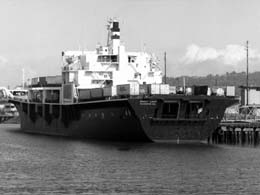On June 4, 1976, with the loading of its vessel Great Land in Tacoma, Totem Ocean Trailer Express (TOTE) signals a move of its operations from the Port of Seattle to the Port of Tacoma in order to keep pace with demand for shipping to Alaska. Tacoma's Local 23 of the International Longshoremen's and Warehousemen's Union (ILWU) agree to training to accommodate the vessel's new "roll on, roll off" technology, and workers accomplish a 14.5-hour loading time their first time around, shorter than the unsatisfactory 18 hours in Seattle. Thus begins TOTE's more than three-decade tenancy at the Port of Tacoma and the Port's growing business with Alaska, which by 2008 reaches 70 percent of all shipping to that state from the continental United States.
Gateway to Alaska
Since the late 1800s and early 1900s, Puget Sound cities have billed themselves as the Gateway to Alaska, whether cashing in on the Klondike Gold Rush of 1897 or promoting themselves for the Alaska-Yukon-Pacific Exposition of 1909. Tacoma has been no exception. And when the TOTE shipping line -- "bringing the world to Alaska since 1975" (TOTE website) -- moved from the Port of Seattle to the Port of Tacoma in 1976, the South Sound city once again claimed gateway status.
In the mid-1970s, Alaska was experiencing booming growth during construction of the Trans-Alaska Pipeline, which was completed in 1977. Growing population meant growing demand for clothes, food, and indeed, nearly all consumer goods, almost all of which had to be transported to the state by ship or truck.
Philadelphia-based Sun Company saw this as an opportunity and in 1975 created the TOTE shipping line to ferry cargo from Seattle to Alaska, using "roll on, roll off" (RO/RO) technology to expedite the loading and unloading of goods -- semitrucks could simply drive onto a ship via hydraulically operated ramps, unload their trailers, and then drive off again, no lifting by crane required. TOTE's first RO/RO vessel was the 790-foot Great Land, able to carry 386 40-foot trailers and 126 vehicles. The ship first sailed in September 1975, from the Port of Seattle to Anchorage, Alaska.
So Long Seattle
In its first year, TOTE struggled to keep up with demand. As it waited for an anticipated June 1976 launch of its second RO/RO ship, the El Taino, TOTE sought to cut the turnaround time for loading cargo on the Great Land at the Port of Seattle. The company said it needed a faster turnarounds to maintain its weekly roundtrip sailing to Anchorage.
TOTE entered negotiations with the Port of Seattle and Seattle's ILWU Local 19, stipulating that the longshoremen receive TOTE training in maneuvering the trailer-loading tractors associated with the RO/RO ships. The original Port of Seattle berth assigned to TOTE, at Pier 37, was also not equipped to efficiently handle the loading capabilities of the Great Land -- only one of the ship's three ramps, the stern ramp, could be used at that dock.
The Port of Seattle moved TOTE to Terminal 20, and in mid-May 1976 the longshoremen of Local 19 were subsequently able to load the Great Land in 18 hours, close to TOTE's goal for Seattle of 16 hours. But TOTE still wanted more speed, and the Seattle local twice voted against TOTE's training program. Even at 18 hours the Great Land had sailed only 90 percent full in order to leave on time. This was unacceptable given that TOTE was straining to compete with the five-ship fleet of its competitor Sea-Land.
TOTE president Bill Acton was also talking with the Port of Tacoma and Tacoma's ILWU Local 23. The local's business agent, George Ginnis, recalls being asked, "Can we [TOTE] train your drivers at our expense and will you guarantee trained drivers?" (Magden, Working Longshoremen, 189). The union said yes, and TOTE announced it would move to Tacoma.
Sweet Home Tacoma
On June 4, 1976, the Great Land docked at the Port of Tacoma. Workers from ILWU Local 23 loaded the ship in 14.5 hours, with only 20 of the longshoremen on the job having been trained in loading the RO/RO-type ship. "That's fantastic for the first time around," a spokesperson from TOTE told the Tacoma News Tribune (Johnson). TOTE's goal for turning around its RO/RO vessels in Tacoma was set at 12 to 13 hours, which became routine by the early 1980s, solidifying TOTE's home at the south sound port.
Alaska trade became a major component of the Port of Tacoma's business: Sea-Land, another Alaska cargo carrier, relocated from Seattle in 1982 (and in 1999 was acquired by the Danish shipping line Maersk, a Port of Tacoma tenant since 1985). TOTE rededicated its upgraded facility on the Port's Blair Waterway in August 2003. And in 2007 the Port and TOTE settled on a new lease through 2034 that called for redeveloping the terminal yet again, expanding it to 72 acres.
With more than 70 percent of Lower 48 shipping to Alaska going through Tacoma, Port of Tacoma Commission president Dick Marzano lauded the 2007 agreement with TOTE: "Over the past three decades, TOTE and the Port have grown together to expand our region's business with Alaska ... ensuring that the Port of Tacoma will remain the Gateway to Alaska for years to come" (Transportweekly).

